Zootopia Writers Talk About Early Unused Concepts And More [Interview]
If you haven't already, please read my interview with Zootopia directors Byron Howard and Rich Moore where they talk about how the latest Disney Animation Studios film evolved from an idea about a James Bond spoof with talking animals.
Today I bring you the other interview that I conducted at Disney's Animal Kingdom with Zootopia producer Clark Spencer, co-writer and co-director Jared Bush and co-writer Phil Johnston. I touch some of the same ground in this interview, talking about the evolution of this story over the development, but we get a lot of new details about some of the material that didn't make the final film. I also talk to them about some of the clever gags and Easter eggs in the movie, and much more.
Zootopia Writers Interview
Peter Sciretta: Okay, so I'm very interested in the creative process and I know you guys have probably answered a lot of questions with the same answers and...Jared Bush: You're getting new answers this time.Peter: (Laughs.) I want new answers. No, but I'm very interested in how things evolve. And I know like you go through so many iterations and whatever. What was like the first, the inception of this whole thing? And how did it evolve over time.Jared: Well early on Byron had this idea. So Byron loved animal movies, talking animal movies. Love them, especially Robin Hood. And early on he had this idea to have two characters, a fox and a bunny together in a world populated by animals. And when I came onto the project it was originally a spy movie. And the first 10 minutes of that movie took place in this mammal world. And then they went to this crazy tropical island where a bunch of other stuff happened. And it was more of a spy movie. And –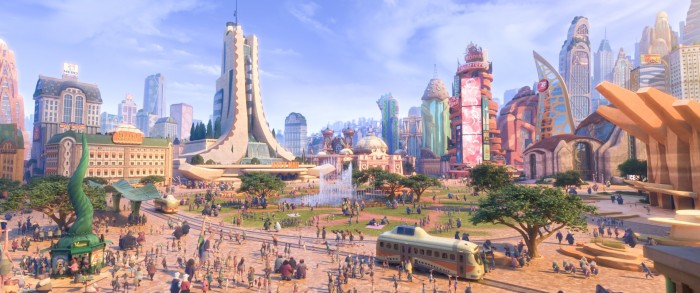 Peter: So it wasn't even set in Zootopia.Jared: No, and he got notes saying, you know what's really awesome is this mammal world. And then you go to this island. Just put the whole thing in this mammal world 'cause it's amazing. And so my first day on the job, I walked in saying okay, so we're a spy movie on this island. And Byron said, no, actually that's all getting thrown away. And I said, what's the movie? So what is it? What's the movie gonna be about? He's like I don't know yet. It's gonna be a fox and a bunny. They're gonna be in this city. Let's go. And so–Peter: So the spy movie didn't have a bunny and a fox?Jared: No, it did have a bunny and a fox, but it was a very different type of a story. And so early on the idea of unraveling some sort of mystery, we wanted to retain that. And as the project continued on and we started to build out the world, originally the fox was the main character as opposed to the rabbit. And took that down a really long path and what kind of life would he have? And we'd spend a lot of time on versions where we got to know his back story, which is a very different back story than it currently is. But then eventually the story started, the movie started to tell you what it wants to be about. And this idea that these animals have preconceived notions of each other became the centerpiece and the thing that we really anchored everything else around.
Peter: So it wasn't even set in Zootopia.Jared: No, and he got notes saying, you know what's really awesome is this mammal world. And then you go to this island. Just put the whole thing in this mammal world 'cause it's amazing. And so my first day on the job, I walked in saying okay, so we're a spy movie on this island. And Byron said, no, actually that's all getting thrown away. And I said, what's the movie? So what is it? What's the movie gonna be about? He's like I don't know yet. It's gonna be a fox and a bunny. They're gonna be in this city. Let's go. And so–Peter: So the spy movie didn't have a bunny and a fox?Jared: No, it did have a bunny and a fox, but it was a very different type of a story. And so early on the idea of unraveling some sort of mystery, we wanted to retain that. And as the project continued on and we started to build out the world, originally the fox was the main character as opposed to the rabbit. And took that down a really long path and what kind of life would he have? And we'd spend a lot of time on versions where we got to know his back story, which is a very different back story than it currently is. But then eventually the story started, the movie started to tell you what it wants to be about. And this idea that these animals have preconceived notions of each other became the centerpiece and the thing that we really anchored everything else around.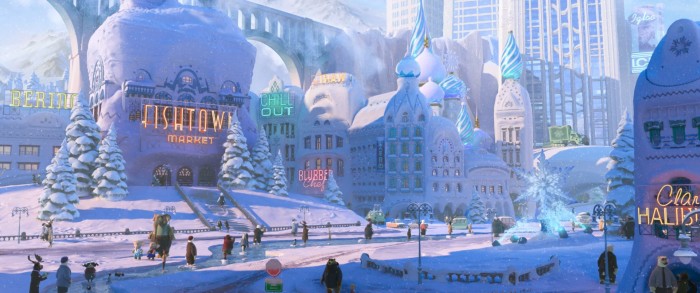 Peter: One of the things I love about the movie is the world building. It feels like a real place. It feels like, you know, I wanna go. I think we talked earlier and I wanna go there. When you get to that point where we're basing it in Zootopia, do you start then like okay, let's start building out the world? Or is it about let's get these characters right? Or is it let's get the story? Like what do you start, what comes first the chicken or the...?Jared: Well, this movie is a little different than most. We did a ton of research up front. So months and months of research. And we, in a way, kind of put the story on hold for a second while we tried to figure out how to build this world. And the world started to tell us those dynamics. We found out through our research that there are 90 percent prey animals in our natural world. 90 prey and only 10 percent predators. And that was a really interesting ratio. And oh, that's really neat. And then we started to look at the animals themselves how they interrelate with each other. So for us on this one, research really did push a lot of the story. Of course at the same time, you're investigating who the characters could be and we knew the fox. We wanted to certainly going off of Robin Hood and having that as something as a jumping off spot. We knew that we wanted to have a really charming, sarcastic, likeable, but kind of snarky guy who was cynical as that fox character. And then it made sense for the rabbit to be a little bit more optimistic. But even those characters changed a lot over the course of the research.Clark: And there's a point where after the research, there's a team of people thinking about what does the world look like? There's a team of people thinking what's the story gonna be about? There's a team of people who are saying, how are we gonna create these animals? What technology do we need? So there's a lot of things happening in parallel that are just about exploration. And then as the story starts to evolve, you start to realize what do we actually need to be built? What character, what types of animals do we actually need for the story? All of those things start to come to light.Phil: It's usually it's difficult to impose story upon character in my opinion. So because once you know your characters, you kind of know how they behave and will react to a given situation. And if you're dictating exactly, you know, building the plot and not letting the characters kind of help you through that, it's I think a recipe for disaster. So I think coming up with strong characters that you know how they would react in a given situation, you know, you figure out what their flaws are and what their the obstacles that are in their way and you make then make it as hard as possible for them. That's a big way, that's how I attack it anyway.
Peter: One of the things I love about the movie is the world building. It feels like a real place. It feels like, you know, I wanna go. I think we talked earlier and I wanna go there. When you get to that point where we're basing it in Zootopia, do you start then like okay, let's start building out the world? Or is it about let's get these characters right? Or is it let's get the story? Like what do you start, what comes first the chicken or the...?Jared: Well, this movie is a little different than most. We did a ton of research up front. So months and months of research. And we, in a way, kind of put the story on hold for a second while we tried to figure out how to build this world. And the world started to tell us those dynamics. We found out through our research that there are 90 percent prey animals in our natural world. 90 prey and only 10 percent predators. And that was a really interesting ratio. And oh, that's really neat. And then we started to look at the animals themselves how they interrelate with each other. So for us on this one, research really did push a lot of the story. Of course at the same time, you're investigating who the characters could be and we knew the fox. We wanted to certainly going off of Robin Hood and having that as something as a jumping off spot. We knew that we wanted to have a really charming, sarcastic, likeable, but kind of snarky guy who was cynical as that fox character. And then it made sense for the rabbit to be a little bit more optimistic. But even those characters changed a lot over the course of the research.Clark: And there's a point where after the research, there's a team of people thinking about what does the world look like? There's a team of people thinking what's the story gonna be about? There's a team of people who are saying, how are we gonna create these animals? What technology do we need? So there's a lot of things happening in parallel that are just about exploration. And then as the story starts to evolve, you start to realize what do we actually need to be built? What character, what types of animals do we actually need for the story? All of those things start to come to light.Phil: It's usually it's difficult to impose story upon character in my opinion. So because once you know your characters, you kind of know how they behave and will react to a given situation. And if you're dictating exactly, you know, building the plot and not letting the characters kind of help you through that, it's I think a recipe for disaster. So I think coming up with strong characters that you know how they would react in a given situation, you know, you figure out what their flaws are and what their the obstacles that are in their way and you make then make it as hard as possible for them. That's a big way, that's how I attack it anyway.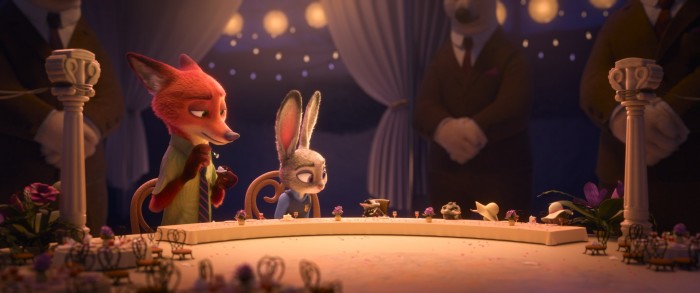 Peter: The film is so clever. Like there, every little character detail, every like little thing in the background, a poster. So many references, but not like in your face. Like just kind of like what populates this world. Can you talk a little bit about some of the, some cool stuff that might be in the background that we might not notice until the 30th viewing or...?Phil: I mean, again, that's sort of a philosophical thing where you don't wanna hammer ideas over an audience's head. So whether it's those little Easter eggs or the theme of the movie or whatever you want people to discover it. And there are innumerable little hidden gags here and there. Let's see...Jared: Yeah, well I think early on the tone of the movie lends itself to those type of things. And so everyone that touches the movie once that tone's been established from story artists to animators to people doing the backgrounds, they know, oh, I'm allowed to do this? Everyone's so excited to be able to do it. And they know any, basically any frame in this movie, you can pause it and find 10 jokes that were never written. Certainly not in any script. It's just people so excited to actually add something to it.Peter: Oh, so that's more part of the collaboration.Jared: Absolutely.Phil: Oh for sure.Clark: And that's what one of the fun parts is as Jared and Phil are saying, letting them own a piece of it too. So when you look at all that signage that's in the movie, that's not these guys writing. It's not the directors coming up with it. It is people come up with wouldn't it be funny if we did this. And once the Preyda [PH] ad came in, once the Bearbury [PH] started to come in, people started to realize, oh, we can do that? And they kept having fun with that and we would send stuff to legal and make sure it was all cleared. And then it would just get all created. And then they'd have to go in and do the set placement where there's a ton of people who are actually thinking about the set. How can I place this idea in here in a subtle way that you won't see it the first time, so it's not like hey, here's a joke? It's just sort of in the background if you're looking at the film for the second or third or fourth time. And even to this day and we've seen the movie so many hundreds of times, they'll be something where I'll suddenly look to the left and realize, oh my God, they put that sign there. That's so funny that that exists. Or this little piece of animation that's happening over here, there's a mouse in a scene in front of a mouse store when we're watching these much taller characters. It's all those pieces that they got to have fun as a team and add into it that wasn't really story dictated. It's more like we have this incredible world that's always remember that it's a character that we should be playing with.Phil: And I guarantee you will find things that I haven't seen still.Jared: Yeah, absolutely.Phil: Things that I have not caught and might not ever catch until they're pointed out to me.
Peter: The film is so clever. Like there, every little character detail, every like little thing in the background, a poster. So many references, but not like in your face. Like just kind of like what populates this world. Can you talk a little bit about some of the, some cool stuff that might be in the background that we might not notice until the 30th viewing or...?Phil: I mean, again, that's sort of a philosophical thing where you don't wanna hammer ideas over an audience's head. So whether it's those little Easter eggs or the theme of the movie or whatever you want people to discover it. And there are innumerable little hidden gags here and there. Let's see...Jared: Yeah, well I think early on the tone of the movie lends itself to those type of things. And so everyone that touches the movie once that tone's been established from story artists to animators to people doing the backgrounds, they know, oh, I'm allowed to do this? Everyone's so excited to be able to do it. And they know any, basically any frame in this movie, you can pause it and find 10 jokes that were never written. Certainly not in any script. It's just people so excited to actually add something to it.Peter: Oh, so that's more part of the collaboration.Jared: Absolutely.Phil: Oh for sure.Clark: And that's what one of the fun parts is as Jared and Phil are saying, letting them own a piece of it too. So when you look at all that signage that's in the movie, that's not these guys writing. It's not the directors coming up with it. It is people come up with wouldn't it be funny if we did this. And once the Preyda [PH] ad came in, once the Bearbury [PH] started to come in, people started to realize, oh, we can do that? And they kept having fun with that and we would send stuff to legal and make sure it was all cleared. And then it would just get all created. And then they'd have to go in and do the set placement where there's a ton of people who are actually thinking about the set. How can I place this idea in here in a subtle way that you won't see it the first time, so it's not like hey, here's a joke? It's just sort of in the background if you're looking at the film for the second or third or fourth time. And even to this day and we've seen the movie so many hundreds of times, they'll be something where I'll suddenly look to the left and realize, oh my God, they put that sign there. That's so funny that that exists. Or this little piece of animation that's happening over here, there's a mouse in a scene in front of a mouse store when we're watching these much taller characters. It's all those pieces that they got to have fun as a team and add into it that wasn't really story dictated. It's more like we have this incredible world that's always remember that it's a character that we should be playing with.Phil: And I guarantee you will find things that I haven't seen still.Jared: Yeah, absolutely.Phil: Things that I have not caught and might not ever catch until they're pointed out to me.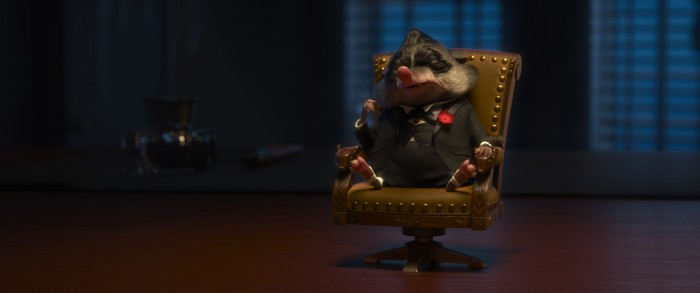 Peter: Being that clever, in working in the animation world, I assume that there's probably tons of ideas that you guys came up with that for some reason or other doesn't fit the story, doesn't fit the world, didn't get in it. What's something that you're kind of angry that you wish you could have got in there, but it just didn't work?
Peter: Being that clever, in working in the animation world, I assume that there's probably tons of ideas that you guys came up with that for some reason or other doesn't fit the story, doesn't fit the world, didn't get in it. What's something that you're kind of angry that you wish you could have got in there, but it just didn't work?
[Jared and Clark look at Phil.]
Phil: What, my butt joke?Jared: Yeah.Phil: One butt joke. It was a wall and when she's going through training camp, she was gonna fall down the wall. And then there was this hole of ice and there was a cop named Major Friedkin. And she was gonna fall and then made this Major Friedkin ice hole. And that's it. We spent a good three hours talking about that.
[Peter laughs a little.]
Clark: See, it would have worked?Phil: Yeah. Not even that good.Jared: There were a lot of locations that we ultimately didn't go to. Originally Nick had this really fun business called Wilde Times where animals could live out there animalistic nature. A predator for instance could chase another predator, but in a prey costume. So they could sort of live those things out. And there was a lot, there was like a really cheesy carnival sort of spectacle thing that he created. That was one of my favorite environments ever, but it ultimately when we made the shift to it being Hopps' story, it didn't make sense for him to have that anymore.Clark: And I think one of the hardest things is all those locations are so much fun and we do get to go into Sahara Square and Tundra Town and Rainforest District and Downtown. Bunnyburrow and those places but you really could spend a whole movie in any one of those. So the hardest thing for everybody was trying to figure out how do we enjoy these locations, but remember we have to stay on story point. Because it would be very easy to say let's just go spend five minutes exploring this one area. Which would be lovely, but not keeping us on story point. So I think everyone had to find that right balance of this incredible world that you really wanna spend time in but we do have a story that had to be told.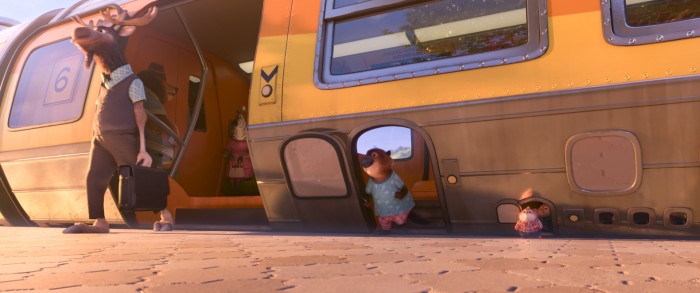 Peter: So is there like a notebook somewhere or a file like with all these ideas that like if there's a sequel, we could explore this or this?Clark: There's a lot of stuff on a shelf. Pending should we ever be so lucky to go, we have definitely and there's stuff that people will see in the Art of book. They'll be scenes on the DVD ultimately when it comes out that'll really showcase just how much more could have been. Again, as story starts to shift and move, you have to start losing ideas or focus. And so we couldn't do –Jared: I have a wall in my house that I just put all those on with little pushpins and how angry I am about each of those things not being there anymore. So I go there every night and stare at it for a couple hours.Peter: Well, thank you guys very much.Clark: Oh thank you.Phil: Thank you.Clark: Very nice to meet you.Peter: It was very nice to meet you guys.
Peter: So is there like a notebook somewhere or a file like with all these ideas that like if there's a sequel, we could explore this or this?Clark: There's a lot of stuff on a shelf. Pending should we ever be so lucky to go, we have definitely and there's stuff that people will see in the Art of book. They'll be scenes on the DVD ultimately when it comes out that'll really showcase just how much more could have been. Again, as story starts to shift and move, you have to start losing ideas or focus. And so we couldn't do –Jared: I have a wall in my house that I just put all those on with little pushpins and how angry I am about each of those things not being there anymore. So I go there every night and stare at it for a couple hours.Peter: Well, thank you guys very much.Clark: Oh thank you.Phil: Thank you.Clark: Very nice to meet you.Peter: It was very nice to meet you guys.
